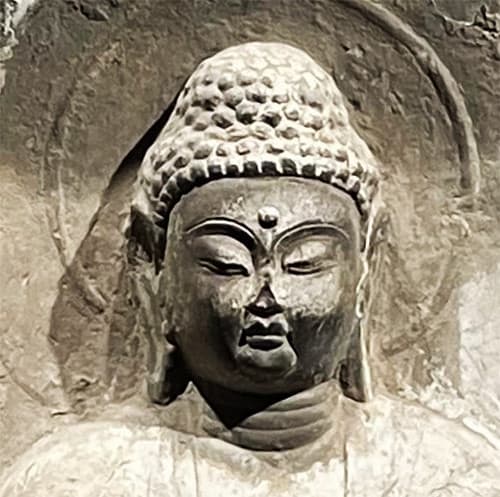




加齢してくるとだんだん仏教などの世界に近づきたくなる(笑)。いま「家整」しているカミさんの実家には仏壇があるので、仏道の初歩の初歩くらいは修行している般若心経を諳んじているわが身としては(笑)、行く度にお詣りいたしています。多少の宗派の違いによる「南無・・・」の相違については聞かないでいただきたいという身勝手さではありますが、衆生の身としては許していただけると思っています。
般若心経を諳んじられるようになったのは、父母の死にあたって兄姉弟で「千願心経」を代わる代わる唱えたことがきっかけでした。以来30-40年以上経っても忘れない。それをまた習慣化させると記憶力の老化防止という意味でもありがたいのではないかと思っています。
ということで、そういう方面には知らず知らず興味が向かっていて、だんだん「仏像」の表情などに面白みを感じるようになっています。
東京国立博物館・東洋館でアジア世界の仏像を展示しているので、先般はじめて心理的に「見比べ見る」機会を得ることができました。
いちばん上が中国のものでその下にくわしい素性説明も付けました。中国の地域名はご確認ください。で、こういう表情で表現されておりました。一方、その下には東南アジアと韓国(朝鮮)の仏像であります。東南アジアの仏像のお顔はやはり、明瞭に現地のひとびとの表情に似つかわしくなっている。
「おお、やはり表情に違いがあるんだ」と率直に受け止めていました。
このあたりは個人の主観でしょうからわたしの受け止め方としていただければ幸い。
仏像って、その制作者にしてみるとその心象がそのままあらわれるようなものだろうと思います。わたしは飛鳥大仏や法隆寺のご本尊を造形した止利仏師の表現に感嘆してこころが奪われた経緯があって、以降、こういう仏像の表情を鑑賞することにハマっている。

これが止利仏師さんの飛鳥大仏。止利さんってたぶん渡来人なのだと思いますが、この飛鳥大仏の造像で高い評価を得たと見えて、その同時代の法隆寺の本尊造像も依頼されたのだと思います。想像ですが、造像にあたってその「依頼者」と当然、顔を合わせて「願い事」の心象を取材したに違いないと思っています。そうすれば残影としてその依頼者とその心象が製作にあたって「反映」することが自然でしょう。蓋然性で考えれば聖徳太子の残影が感じられもする。
アジア各地域でそういった製作経緯は共通だっただろうことを考えれば、それぞれの地域の事情や風土性などが仏像の表情に反映していくことは間違いがない。
その願い事が仏教という世界宗教であることで、こういう地域ごとの文化が比較対照できることもごく自然に受け止められる。ときどきこの写真群を見て、歴史時間を楽しんでおります。
おお、やばい、だんだん浄土世界と縁が近づいて行ってしまう(笑)・・・
English version⬇
The expressions on the faces of Buddhist statues, and the differences between Asians that I suddenly notice.
Since visiting the Great Buddha of Asuka, I have been fascinated by the way the creator of the statue, Buddhist monk Tori, looks at human beings. I have been thinking about the differences and similarities in the expressions of world religions and Buddhist statues. I am also fascinated by the differences and commonalities in the expression of Buddhist statues of world religions.
As I get older, I want to get closer and closer to the world of Buddhism (laugh). My wife's parents have a Buddhist altar at their home, so I pay my respects there every time I go there, because I can recite the Heart Sutra, which I have practiced at least the rudiments of the Buddhist Way (laugh). I am selfish enough not to ask about the difference in "Namu..." due to some differences in religious sects, but as a sentient being, I believe that I can be forgiven for this.
I came to be able to recite the Heart Sutra when my siblings and I took turns reciting the "Sengan Shinkyou" after the death of our parents. More than 30-40 years have passed since then and I have not forgotten it. I believe that making it a habit again would also be gratifying in terms of preventing the aging of my memory.
So, my interest has been growing in this direction without my knowing it, and I am gradually becoming more and more interested in the expressions on the faces of "Buddhist statues".
The Toyokan (Asian Gallery) of the Tokyo National Museum exhibits Buddhist statues from around the world, and recently I had the opportunity to "compare and contrast" them psychologically for the first time.
The top one is from China, and below it I have added a detailed description of its background. Please check the names of the regions in China. The top one is from China, and below it is a detailed description of the region. On the other hand, below them are Buddha images from Southeast Asia and Korea. The faces of the Southeast Asian Buddha images clearly resemble the expressions of the local people.
I was frankly impressed by the difference in facial expressions.
This is a matter of personal taste, so I hope you will accept it as I do.
I think that Buddhist statues are something that express the creator's mental image of the statue as it is. I have been fascinated by the expressions of the Asuka Daibutsu (Great Buddha) and the main image of Horyuji Temple, which I admired so much that I have since become addicted to appreciating the expressions on the faces of Buddhist statues.

This is Asuka Daibutsu (Great Buddha) made by Buddhist priest Shuri. I believe that he was commissioned to create the main image of Horyuji Temple in the same period. I imagine that he must have met with the client and interviewed him about his wishes. It would be natural that the client and his image would be "reflected" in the creation of the statue as an afterimage. If we think of it in terms of probability, we can also feel the afterimage of Prince Shotoku.
Considering the fact that the process of production would have been the same in each region of Asia, there is no doubt that the circumstances and climate of each region would be reflected in the expression of the Buddha statues.
Since Buddhism is a world religion, it is quite natural that we can compare and contrast the cultures of different regions. Sometimes I look at this group of photos and enjoy the historical time.
Oh, no, I am getting closer and closer to the Pure Land world (laugh)...




















「生きるものすべての身」って、どういうことさ?
「衆生救い」っていうそうで、菩薩がこの世で迷っている衆生(生類)を悟りに導くそうです。へぇ~って話です。
「衆生の身」詳しくおせーてね。